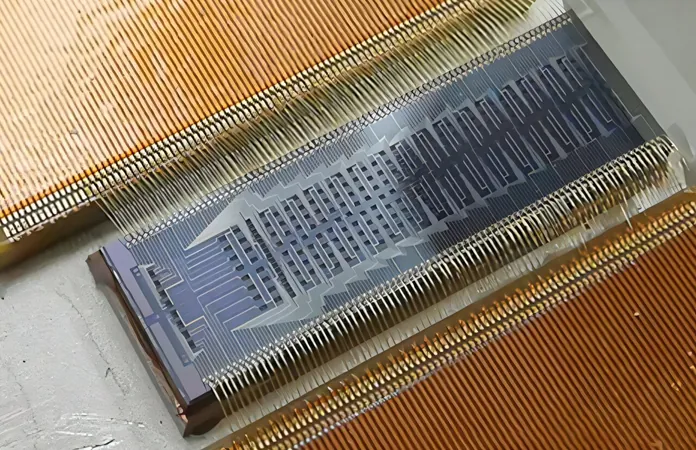
Revolutionizing Quantum Technology: Near-Unity Quantum Efficiency Achieved in 2D Photon Emitters!
2024-12-17
Author: Rajesh
Introduction
In an astonishing leap for quantum technology, researchers at Nanyang Technological University (NTU) have accomplished a groundbreaking feat by achieving near-unity quantum efficiency in two-dimensional (2D) photon emitters. This innovation stands to accelerate the development of quantum computing and revolutionize various applications, including quantum communications and scalable optical quantum computations!
Unprecedented Breakthrough in Photon Emission
The NTU research team, under the leadership of Prof. Gao Weibo, has made remarkable strides in enhancing photon emission. By employing ultrathin 2D materials like tungsten diselenide (WSe2) combined with arrays of gold pillars, the team successfully achieved an average quantum efficiency of 76.4%, with some emitters reaching over 90%. This marks the first instance of near-unity quantum efficiency being realized in 2D materials, inching closer to the ideal target of 100%.
“In our exploration, we discovered that the probability of non-radiative decay—the process through which an emitted photon fails to be released—must approach zero to attain near-unity efficiency,” explained Dr. Abdullah Rasmita, a key contributor to the research. To mitigate non-radiative decay, the team applied an electric field that effectively separated the exciton's positive and negative charges, enabling this remarkable efficiency.
Slowing Light for Enhanced Quantum Processing
Slowing the speed of light is essential for effective quantum information processing. Traditional photonic chips have struggled with light backscattering, which inhibits efficient transmission when light encounters obstacles. However, researchers have innovated a new chip design using photonic Chern insulators, allowing light to slow down significantly and navigate around multiple frequencies without loss of efficiency.
As explained by Prof. Zhang Baile, one of the leaders of this collaborative effort, “This new chip design surmounts challenges posed by conventional slow-light devices, setting the stage for advancements in quantum memory, which is vital for processing quantum information.”
Room-Temperature Light-Matter Interactions Unlocked!
Traditionally, superconducting quantum circuits have been limited by the need for ultra-low temperatures, imposing high cooling costs. Now, a new revelation allows researchers to achieve ultra-strong coupling between excitons in tungsten disulfide (WS2) flakes and surface plasmons at room temperature. This transformative breakthrough opens up significant possibilities for quantum computing applications without the constraints of cooling technologies.
Prof. Wang Qi Jie remarked, “This finding not only reduces energy costs for quantum computing but also paves the way for exploring innovative light-matter interactions and understanding complex quantum phenomena.”
Using Quantum Chips to Accelerate Drug Discovery
Beyond computing, light's potential in facilitating drug discovery is extraordinary. NTU scientists have developed a quantum processing chip that uses photons to unveil the chemical properties of molecules—an endeavor that could dramatically shorten the drug discovery timeline. Engaging a technique known as scattershot boson sampling, the researchers simulated the vibronic spectra of various molecules, such as formic acid and thymine.
“With quantum photonic chips, we're harnessing computational power that far surpasses traditional methods, providing new insights into larger molecules,” noted Prof. Kwek Leong Chuan, co-director of NTU’s Quantum Science and Engineering Center.
Conclusion
As these revolutionary discoveries unfold, the implications for quantum technology are immense, potentially reshaping not only computing but also breakthroughs in medicine, materials science, and beyond. The race to harness the power of quantum technology is heating up, and NTU is at the forefront of this exciting journey! Stay tuned for further updates on this field that promises to change the future as we know it!

 Brasil (PT)
Brasil (PT)
 Canada (EN)
Canada (EN)
 Chile (ES)
Chile (ES)
 Česko (CS)
Česko (CS)
 대한민국 (KO)
대한민국 (KO)
 España (ES)
España (ES)
 France (FR)
France (FR)
 Hong Kong (EN)
Hong Kong (EN)
 Italia (IT)
Italia (IT)
 日本 (JA)
日本 (JA)
 Magyarország (HU)
Magyarország (HU)
 Norge (NO)
Norge (NO)
 Polska (PL)
Polska (PL)
 Schweiz (DE)
Schweiz (DE)
 Singapore (EN)
Singapore (EN)
 Sverige (SV)
Sverige (SV)
 Suomi (FI)
Suomi (FI)
 Türkiye (TR)
Türkiye (TR)
 الإمارات العربية المتحدة (AR)
الإمارات العربية المتحدة (AR)